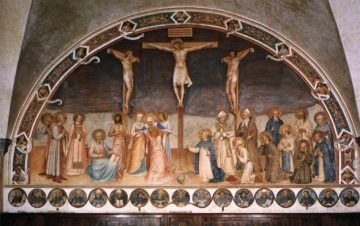Cody Delistraty in The Paris Review:
 The fifteenth-century Italian artist Fra Angelico invented emotional interiority in art; laid the stylistic groundwork for Michelangelo, Leonardo da Vinci, and Mark Rothko; and theorized a utopian world, one in which everything and everyone is ultimately linked.
The fifteenth-century Italian artist Fra Angelico invented emotional interiority in art; laid the stylistic groundwork for Michelangelo, Leonardo da Vinci, and Mark Rothko; and theorized a utopian world, one in which everything and everyone is ultimately linked.
In the summer of 1873, Henry James visited a former monastery on Piazza San Marco in Florence. Surrounded by a scattering of low-slung, washed-out government buildings and conical Tuscan cypresses, the church and convent were in what is still the city’s center. When James first entered the convent, he saw Fra Angelico’s The Crucifixion with Saints in the chapter room. A brightly colored, semicircle fresco about thirty feet wide, Crucifixion depicts Christ and the two thieves on either side of him, nailed to their crosses, as saints and witnesses grieve below. “I looked long,” James wrote. “One can hardly do otherwise.” As the author moved throughout what had then just become a museum, he felt a spiritual urge, even though he had rejected his Christian upbringing. “You may be as little of a formal Christian as Fra Angelico was much of one,” he wrote in Italian Hours. “You yet feel admonished by spiritual decency to let so yearning a view of the Christian story work its utmost will on you.” Even Angelico’s colors, he added, seem divinely infinite, “dissolved in tears that drop and drop, however softly, through all time.”
More here.
